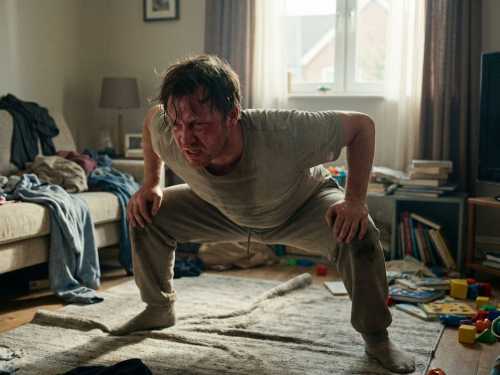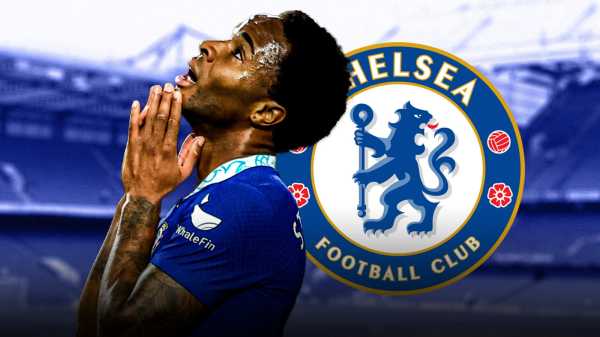
Thomas Tuchel said Raheem Sterling’s £47.5m signing from rivals Manchester City was Chelsea’s “No 1 priority” back in July. Less than four months later, Tuchel is gone and working out how to get the best from the 27-year-old is fast becoming Graham Potter’s No 1 concern.
Tuchel was understandably enthused by the capture of a four-time Premier League winner from a fellow big-six side and highlighted the “flexibility, mobility and attacking options at the front” the 27-year-old would add to his side.
Tuchel’s replacement Potter has spoken similarly of Sterling since taking the reins at Stamford Bridge, praising his “flexibility, ability and quality to play in several positions.”
- Premier League table
- Chelsea fixtures | Results
- Watch free Premier League highlights
But whereas his predecessor immediately installed Sterling into the attack, Potter has utilised the England international’s tactical versatility by deploying him in a variety of positions – including wing-back.
Even while the head coach enjoyed a nine-game unbeaten run at the start of his Chelsea career, his use of Sterling raised eyebrows. Whether playing as a winger, a striker or as a wing-back, the fact remains that Sterling has just one goal and one assist under Potter.
Trending
- Papers: Saka could face Chelsea on Sunday | Arsenal in Saliba talks
- World Cup 2022 schedule, teams and draw
- No Conte for Spurs at Marseille | Ex-Gunner Sanchez: A great joy to beat them
- Merson Says: Liverpool slump ‘inexcusable’; De Bruyne delivers greatness
- Pogba to miss World Cup with knee injury
- Transfer Centre LIVE! RB Leipzig’s Laimer on Liverpool’s midfield list
- Klopp: It’s not fair to judge Liverpool now, do it at the end of the season
- Manchester club appeal to FA after penalty for fielding non-binary player
- What’s going wrong for Sterling at Chelsea – and what does it mean for England?
- Button doubts Ricciardo F1 return if he sits out 2023
- Video
- Latest News
With a World Cup on the horizon, there’s a danger that Chelsea and Potter’s problem also becomes one shared by England and Gareth Southgate.
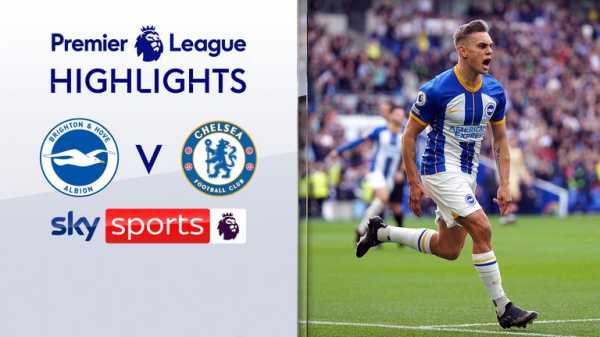
FREE TO WATCH: Highlights from Brighton’s win against Chelsea in the Premier League in which Raheem Sterling lined up at left wing-back
Why has Sterling been playing at wing-back?
After spending the majority of his seven years at City as a winger, Sterling has not only had to adapt to a new club but also a range of new positions following his return to London with Chelsea.
Also See:
The former QPR youngster initially lined up as a false nine in Tuchel’s 3-4-3 system before finding himself playing as part of a front two alongside Kai Havertz once the head coach switched to a 4-4-2.
The tweak seemed to suit Sterling who, after going scoreless in his first three games, then scored three times in his next two matches.
But Potter’s arrival has seen Sterling moved again, with deployments at both right and left wing-back – as well as a role in the front three – as the former Brighton boss has largely reverted Chelsea to a three-at-the-back formation.
As well as wanting to take advantage of Sterling’s “flexibility”, Potter also cited injuries as a reason for his use of Sterling. The head coach admitted “it’s not straightforward with losing the players we have” and that he is “constantly trying to find the right balance.”
Potter has had to cope with the losses of Reece James, Wesley Fofana and N’Golo Kante, with the absence of James – Chelsea’s only true right wing-back – causing a particular headache.
Sterling was the first player tasked with replacing James but that experiment was ended after only 45 minutes at Aston Villa. In the four matches since, Ruben Loftus-Cheek and Cesar Azpilicueta have each started one match at right wing-back, while Christian Pulisic has started there twice. It’s clear that Potter is still searching for the best way to cope with the loss of James.
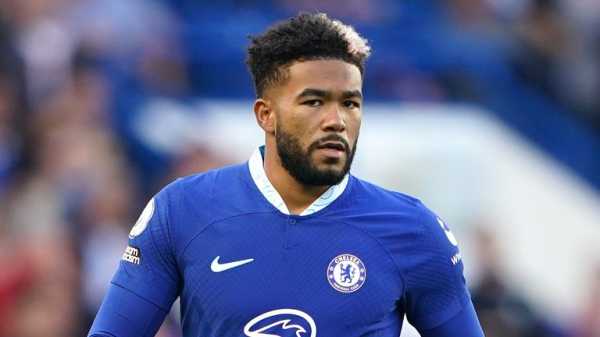
Image: Reece James could miss the World Cup after injuring his knee away to AC Milan
Since that afternoon at Villa Park, Sterling’s action at wing-back has instead largely come on the left. His first game there was at home to Red Bull Salzburg in Potter’s first game – when James started on the opposite flank – and three of Sterling’s last four appearances have come in that role. That is despite Ben Chilwell and Marc Cucurella – two natural left wing-backs – being available.
There is, of course, an element of Potter still getting to grips with a Chelsea squad he inherited just a week after the closure of a transfer window that saw the Blues sign eight first-team players. The 47-year-old has also been deprived of time to work with his squad on the training pitch due to the compressed schedule as a result of the winter World Cup, meaning many tactical experiments have had to be carried out in public view on match days.
Clues to Potter’s tactical ideas upon joining Chelsea were also on show during his time at Brighton, when he often switched between three and four-man defences and helped to turn wingers like Solly March and Leandro Trossard into wing-backs.
After Sterling’s first outing as a wing-back in the 1-1 home draw with Salzburg, Potter said the Austrians’ ability to “block the middle” was behind his use of the former City player.
Salzburg played in a 4-3-1-2 formation, meaning Sterling had no winger to contend with, while Villa’s 4-3-2-1 and Brentford’s 3-5-2 – in theory – provided similar opportunities for him to use his attacking talents in one-on-one match-ups with opposition defenders.
In the two matches against AC Milan and for the visit of Manchester United – teams that do play with wingers – it was telling that Potter moved Sterling back into the attack and played more orthodox defenders at wing-back.
Has Potter’s experiment worked?
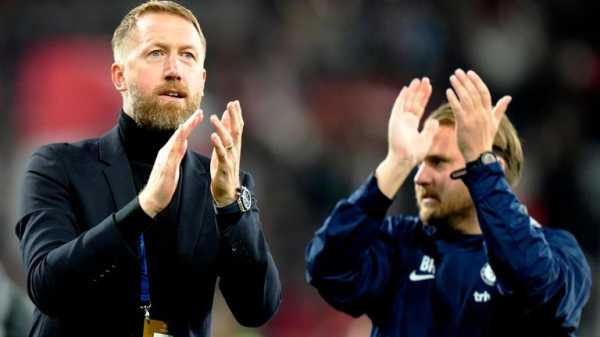
Image: Graham Potter applauds the Chelsea fans after Chelsea's win Salzburg
It’s fair to wonder whether Potter regrets lining Sterling and Pulisic up as wing-backs at Brighton on Saturday, when the head coach’s return to the south coast ending in a humbling 4-1 defeat to his former club.
The two wingers had played in similar roles in the 2-1 win at Salzburg a few days earlier, which perhaps provided Potter with the confidence to stick with such a bold plan at the Amex Stadium.
Brighton had regularly used a 3-4-3 formation under Potter’s successor Roberto De Zerbi which, if repeated, meant Sterling would again be able to push into the final third from wing-back, safe in the knowledge there was no winger waiting to pounce in the space he had vacated.
However, De Zerbi moved to a 4-2-3-1 for the visit of Chelsea, which appeared to catch the visitors out as Brighton swarmed all over them in the opening exchanges. By the time Sterling was withdrawn, the Blues were well on their way to a heavy defeat.
Before their clash with the Seagulls, Chelsea had conceded just four times in their nine matches under Potter, which suggests his tactical chopping and changing didn’t have an adverse effect on his team’s defensive performances.
But has Potter’s tinkering negatively impacted Sterling? The table below shows he registers fewer goals, assists and take-ons per 90 minutes from wing-back than he does when playing in a more advanced role.
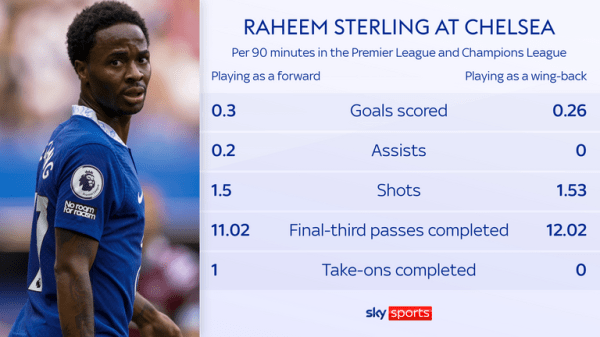
However, the difference in Sterling’s output when looking at these metrics isn’t as stark as could perhaps be expected – with the exception of the fact he is yet to complete a take-on from wing-back. But he has managed to record more shots and final-third passes from a more withdrawn role, showing his attacking output hasn’t been hugely reduced by Potter’s experiment.
This can perhaps be explained by Potter appearing to ask Sterling to play in an extremely attacking manner from wing-back. The graphic below shows the average positions taken up by Sterling in the matches when he has played in that position and shows he has spent almost all of his time in the opponents’ half.

What is more concerning for Chelsea is how greatly Sterling’s attacking output has declined since he left City. The table below shows his totals for goals, assists, shots, completed take-ons and final-third passes have all dropped since he swapped the Etihad Stadium for Stamford Bridge.

Should England be concerned?
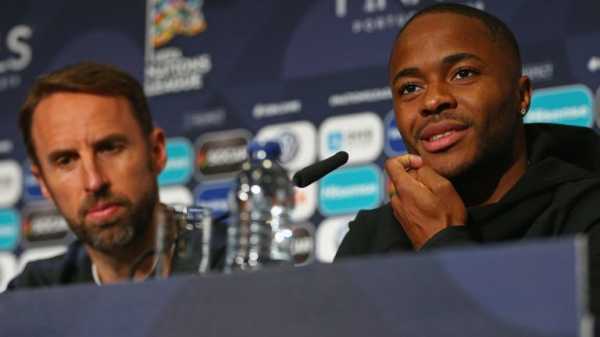
Image: Sterling is a key player under Gareth Southgate
Given the fitness concerns surrounding Reece James, Kyle Walker and Kyle Walker-Peters, plus Gareth Southgate’s apparently lukewarm feelings towards Trent Alexander-Arnold, it will be interesting to see whether the England manager takes note of Sterling’s performances at wing-back ahead of the World Cup.
The mixed results produced in that position by Sterling – no one’s idea of a natural defender – may not encourage Southgate to copy Potter’s blueprint, particularly given he is on record as saying Alexander-Arnold’s lack of opportunities at right wing-back are at least in part due to his “all-round game” being behind his rivals’.
But the more obvious reason for Southgate snubbing Sterling as a wing-back is that he will already be penned in as a key component of the attack in Qatar. The former Liverpool player has 79 caps and 19 goals for his country – the majority of which have come under Southgate – and was named in UEFA’s team of the tournament at Euro 2020, when he played exclusively in the forward line.
There are parallels to be drawn between Sterling’s current situation and the one in which he found himself going into that tournament. In the summer of 2021, Sterling was coming off a season with City that saw him record his lowest combined goals and assists total in five years, while he missed out on the starting XI in all but two of the team’s knockout matches on their way to the Champions League final.
While Sterling’s place in Chelsea’s team remains safe, his performances are again being questioned in the build up to a major international tournament. Southgate and England will be hoping he can respond the way he did 18 months ago – by helping to inspire the team all the way to the final.
How does Sterling bounce back?
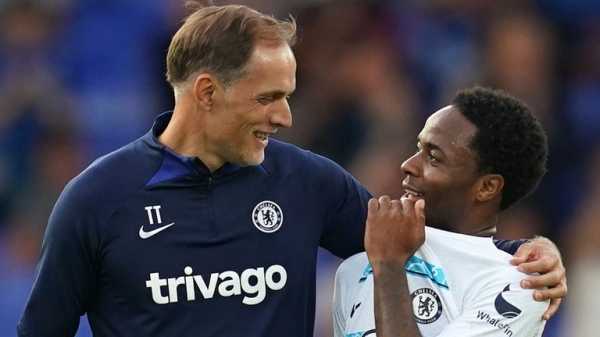
Image: Sterling spoke of his excitement at working with Thomas Tuchel after joining Chelsea
Given Sterling’s output in a Chelsea shirt hasn’t drastically differed depending on his position, it cannot be as simple as saying that restoring him to a regular role in the attack will bring about a revival of his fortunes. Potter also needs to be given leeway regarding his selections as he gets to grips with a new squad amid a hectic fixture schedule.
While Sterling said after joining Chelsea that he was excited to work “under Thomas [Tuchel]’s management” he has been positive about Potter’s use of him as a wing-back, saying he “enjoyed” the role and that “over time it’ll get better” following the draw against Salzburg.
But the fact remains that, in over 450 senior club appearances, Sterling has started fewer than a dozen of those as a wing-back – some of which came under Brendan Rodgers at Liverpool the best part of a decade ago.
Since the start of the 2017/18 season, only three players (Mohamed Salah, Harry Kane and Jamie Vardy) have scored more Premier League goals than Sterling, who spent the majority of that time as a left-winger under Pep Guardiola at City.
With Chilwell and Cucurella more natural options at left wing-back, redeploying Sterling as an attacker is easily done. Being offered a more consistent and familiar role in the side would surely help Sterling to adapt to Chelsea – and to Potter – after so long under Guardiola’s spell in Manchester.

Win £250,000 with Super 6!
Another Saturday, another chance to win £250,000 for free with Super 6. Entries by 3pm Saturday.
Sourse: skysports.com


